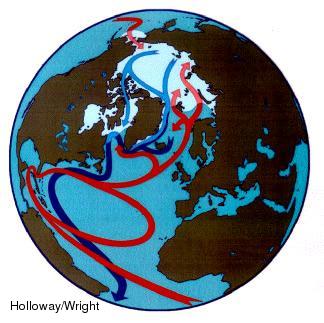|
|
Expedition
Expedition | People | More Pictures | Maps
|
The science: Some motivation for non-oceanographers!
What are we doing? The aim of our project is to measure the freshwater flux passing through Nares Strait (one of three major passages connecting the Arctic and the Atlantic through the Canadian Archipelago) in the form of freshened sea-water and ice, as well as its variability, and to determine what sets its strength.
Why?? The relatively fresh water leaving Nares Strait and the rest of the Canadian Archipelago enters the Atlantic via the Labrador Sea. This is one of the few critical regions where surface water sinks to form deep water as part of the thermohaline overturning circulation. The amount of freshwater input into the ocean here influences the surface density, and therefore has the potential to significantly affect the strength of the thermohaline circulation and climate.
 More about the thermohaline circulation
More about the thermohaline circulation
The oceans thermohaline circulation is a global circulation involving all of the world's major ocean basins. Water sinks in the high-latitude North Atlantic, where the strong surface cooling results in deep convection, and then flows southwards at depth. It returns to the surface in the Indian, Pacific and Southern Oceans, and finally flows northwards again as a warm surface current in the Atlantic. This circulation is responsible for transporting approximately 1 PW (1015 Watts) of heat northwards in the Atlantic basin, and as such has a significant impact on climate, keeping temperatures in northern Europe far warmer than the average for their latitude.
The thermohaline circulation also plays a key role in the carbon cycle. Carbon dioxide is more soluble at high latitudes where surface water temperatures are cold, and becomes sequestered in the deep ocean when this water sinks. The amount of carbon in the deep ocean is more than 50 times the atmospheric carbon inventory, and is increasing at a rate of 2 Gigatons of carbon per year (approximately 30% of the anthropogenic carbon produced)
Recent evidence, however, suggests that the ocean circulation has not always functioned in the same way. And state-of-the-art numerical climate models suggest that as a result of global warming the thermohaline circulation may weaken significantly in the future over the course of just a few decades. Such a change could be far more abrupt than the gradual changes associated directly with global warming, and could have severe consequences for global climate. Society's adaptation to change would be easier if more was known about the mechanisms that might cause such sudden changes, and the ways in which the ocean and atmosphere interact.
A key piece of the puzzle lies in understanding the influence of the polar regions on ocean circulation. The sinking of the thermohaline circulation occurs in very specific locations in the Labrador and Nordic Seas where water remains for long enough to be cooled substantially by the atmosphere, and hence becomes dense enough to sink to great depths. However, the surface density in these critical regions is also influenced by the outflow of fresh water from the Arctic Ocean via Fram Strait and the Canadian Archipelago. Relatively little is known about the amount of fresh water exchanged between the Arctic and Atlantic, or about what governs this. Making reliable measurements at high latitudes presents an enormous challenge to oceanographers, and existing data is sparse.
Over recent decades the critical sinking regions, and the North Atlantic in general, have freshened considerably. This project is part of an intensified effort to establish the importance of fresh water outflow from the Arctic, a thorough understanding of which is essential if we are to predict the response of the ocean circulation to global warming, and the resulting impact on climate.
[Helen Johnson] |
This material is based upon work supported by the National Science Foundation under Grant No. 0230236. Any opinions, findings, and conclusions or recommendations expressed in this material are those of the author(s) and do not necessarily reflect the views of the National Science Foundation.
|
|
